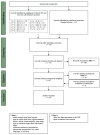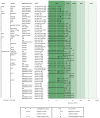Postmortem Protein Degradation as a Tool to Estimate the PMI: A Systematic Review
- PMID: 33256203
- PMCID: PMC7760775
- DOI: 10.3390/diagnostics10121014
Postmortem Protein Degradation as a Tool to Estimate the PMI: A Systematic Review
Abstract
Objectives: We provide a systematic review of the literature to evaluate the current research status of protein degradation-based postmortem interval (PMI) estimation. Special attention is paid to the applicability of the proposed approaches/methods in forensic routine practice. Method: A systematic review of the literature on protein degradation in tissues and organs of animals and humans was conducted. Therefore, we searched the scientific databases Pubmed and Ovid for publications until December 2019. Additional searches were performed in Google Scholar and the reference lists of eligible articles. Results: A total of 36 studies were included. This enabled us to consider the degradation pattern of over 130 proteins from 11 different tissues, studied with different methods including well-established and modern approaches. Although comparison between studies is complicated by the heterogeneity of study designs, tissue types, methods, proteins and outcome measurement, there is clear evidence for a high explanatory power of protein degradation analysis in forensic PMI analysis. Conclusions: Although only few approaches have yet exceeded a basic research level, the current research status provides strong evidence in favor of the applicability of a protein degradation-based PMI estimation method in routine forensic practice. Further targeted research effort towards specific aims (also addressing influencing factors and exclusion criteria), especially in human tissue will be required to obtain a robust, reliable laboratory protocol, and collect sufficient data to develop accurate multifactorial mathematical decomposition models.
Keywords: degradation; postmortem interval; protein; time since death.
Conflict of interest statement
The authors declare that they have no conflict of interest.
Figures







References
-
- Mathur A., Agrawal Y.K. An overview of methods used for estimation of time since death. Aust. J. Forensic Sci. 2011;43:275–285. doi: 10.1080/00450618.2011.568970. - DOI
-
- Henssge C., Knight B., Krompecher T.H., Madea B., Nokes L. The Estimation of the Time since Death in the Early Post-Mortem Period. Eward Arnold; London, UK: 1995.
Publication types
Grants and funding
LinkOut - more resources
Full Text Sources

